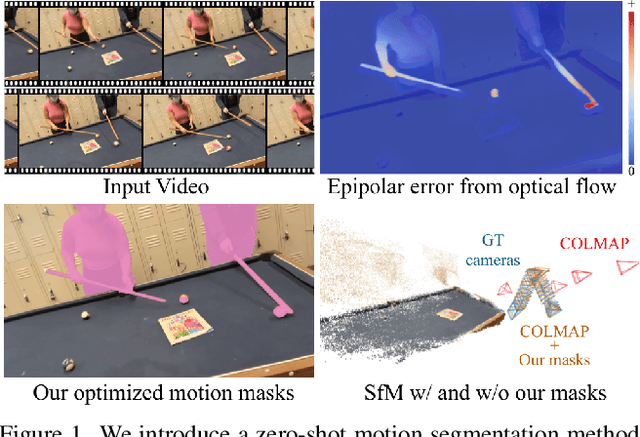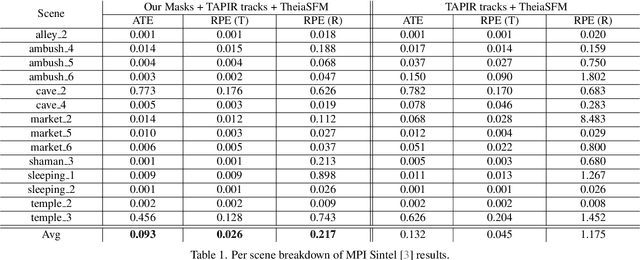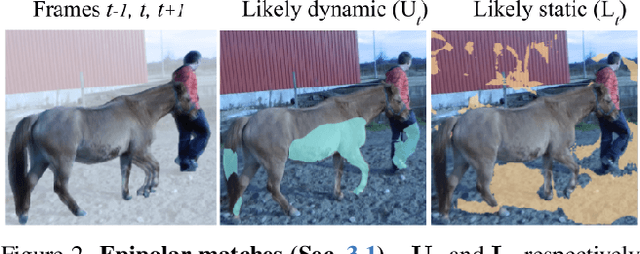Andrea Tagliasacchi
Google Research
Cora: Correspondence-aware image editing using few step diffusion
May 29, 2025Abstract:Image editing is an important task in computer graphics, vision, and VFX, with recent diffusion-based methods achieving fast and high-quality results. However, edits requiring significant structural changes, such as non-rigid deformations, object modifications, or content generation, remain challenging. Existing few step editing approaches produce artifacts such as irrelevant texture or struggle to preserve key attributes of the source image (e.g., pose). We introduce Cora, a novel editing framework that addresses these limitations by introducing correspondence-aware noise correction and interpolated attention maps. Our method aligns textures and structures between the source and target images through semantic correspondence, enabling accurate texture transfer while generating new content when necessary. Cora offers control over the balance between content generation and preservation. Extensive experiments demonstrate that, quantitatively and qualitatively, Cora excels in maintaining structure, textures, and identity across diverse edits, including pose changes, object addition, and texture refinements. User studies confirm that Cora delivers superior results, outperforming alternatives.
Triangle Splatting for Real-Time Radiance Field Rendering
May 25, 2025



Abstract:The field of computer graphics was revolutionized by models such as Neural Radiance Fields and 3D Gaussian Splatting, displacing triangles as the dominant representation for photogrammetry. In this paper, we argue for a triangle comeback. We develop a differentiable renderer that directly optimizes triangles via end-to-end gradients. We achieve this by rendering each triangle as differentiable splats, combining the efficiency of triangles with the adaptive density of representations based on independent primitives. Compared to popular 2D and 3D Gaussian Splatting methods, our approach achieves higher visual fidelity, faster convergence, and increased rendering throughput. On the Mip-NeRF360 dataset, our method outperforms concurrent non-volumetric primitives in visual fidelity and achieves higher perceptual quality than the state-of-the-art Zip-NeRF on indoor scenes. Triangles are simple, compatible with standard graphics stacks and GPU hardware, and highly efficient: for the \textit{Garden} scene, we achieve over 2,400 FPS at 1280x720 resolution using an off-the-shelf mesh renderer. These results highlight the efficiency and effectiveness of triangle-based representations for high-quality novel view synthesis. Triangles bring us closer to mesh-based optimization by combining classical computer graphics with modern differentiable rendering frameworks. The project page is https://trianglesplatting.github.io/
StochasticSplats: Stochastic Rasterization for Sorting-Free 3D Gaussian Splatting
Mar 31, 2025Abstract:3D Gaussian splatting (3DGS) is a popular radiance field method, with many application-specific extensions. Most variants rely on the same core algorithm: depth-sorting of Gaussian splats then rasterizing in primitive order. This ensures correct alpha compositing, but can cause rendering artifacts due to built-in approximations. Moreover, for a fixed representation, sorted rendering offers little control over render cost and visual fidelity. For example, and counter-intuitively, rendering a lower-resolution image is not necessarily faster. In this work, we address the above limitations by combining 3D Gaussian splatting with stochastic rasterization. Concretely, we leverage an unbiased Monte Carlo estimator of the volume rendering equation. This removes the need for sorting, and allows for accurate 3D blending of overlapping Gaussians. The number of Monte Carlo samples further imbues 3DGS with a way to trade off computation time and quality. We implement our method using OpenGL shaders, enabling efficient rendering on modern GPU hardware. At a reasonable visual quality, our method renders more than four times faster than sorted rasterization.
NoKSR: Kernel-Free Neural Surface Reconstruction via Point Cloud Serialization
Feb 19, 2025Abstract:We present a novel approach to large-scale point cloud surface reconstruction by developing an efficient framework that converts an irregular point cloud into a signed distance field (SDF). Our backbone builds upon recent transformer-based architectures (i.e., PointTransformerV3), that serializes the point cloud into a locality-preserving sequence of tokens. We efficiently predict the SDF value at a point by aggregating nearby tokens, where fast approximate neighbors can be retrieved thanks to the serialization. We serialize the point cloud at different levels/scales, and non-linearly aggregate a feature to predict the SDF value. We show that aggregating across multiple scales is critical to overcome the approximations introduced by the serialization (i.e. false negatives in the neighborhood). Our frameworks sets the new state-of-the-art in terms of accuracy and efficiency (better or similar performance with half the latency of the best prior method, coupled with a simpler implementation), particularly on outdoor datasets where sparse-grid methods have shown limited performance.
Radiant Foam: Real-Time Differentiable Ray Tracing
Feb 03, 2025



Abstract:Research on differentiable scene representations is consistently moving towards more efficient, real-time models. Recently, this has led to the popularization of splatting methods, which eschew the traditional ray-based rendering of radiance fields in favor of rasterization. This has yielded a significant improvement in rendering speeds due to the efficiency of rasterization algorithms and hardware, but has come at a cost: the approximations that make rasterization efficient also make implementation of light transport phenomena like reflection and refraction much more difficult. We propose a novel scene representation which avoids these approximations, but keeps the efficiency and reconstruction quality of splatting by leveraging a decades-old efficient volumetric mesh ray tracing algorithm which has been largely overlooked in recent computer vision research. The resulting model, which we name Radiant Foam, achieves rendering speed and quality comparable to Gaussian Splatting, without the constraints of rasterization. Unlike ray traced Gaussian models that use hardware ray tracing acceleration, our method requires no special hardware or APIs beyond the standard features of a programmable GPU.
AC3D: Analyzing and Improving 3D Camera Control in Video Diffusion Transformers
Dec 02, 2024



Abstract:Numerous works have recently integrated 3D camera control into foundational text-to-video models, but the resulting camera control is often imprecise, and video generation quality suffers. In this work, we analyze camera motion from a first principles perspective, uncovering insights that enable precise 3D camera manipulation without compromising synthesis quality. First, we determine that motion induced by camera movements in videos is low-frequency in nature. This motivates us to adjust train and test pose conditioning schedules, accelerating training convergence while improving visual and motion quality. Then, by probing the representations of an unconditional video diffusion transformer, we observe that they implicitly perform camera pose estimation under the hood, and only a sub-portion of their layers contain the camera information. This suggested us to limit the injection of camera conditioning to a subset of the architecture to prevent interference with other video features, leading to 4x reduction of training parameters, improved training speed and 10% higher visual quality. Finally, we complement the typical dataset for camera control learning with a curated dataset of 20K diverse dynamic videos with stationary cameras. This helps the model disambiguate the difference between camera and scene motion, and improves the dynamics of generated pose-conditioned videos. We compound these findings to design the Advanced 3D Camera Control (AC3D) architecture, the new state-of-the-art model for generative video modeling with camera control.
RoMo: Robust Motion Segmentation Improves Structure from Motion
Nov 27, 2024



Abstract:There has been extensive progress in the reconstruction and generation of 4D scenes from monocular casually-captured video. While these tasks rely heavily on known camera poses, the problem of finding such poses using structure-from-motion (SfM) often depends on robustly separating static from dynamic parts of a video. The lack of a robust solution to this problem limits the performance of SfM camera-calibration pipelines. We propose a novel approach to video-based motion segmentation to identify the components of a scene that are moving w.r.t. a fixed world frame. Our simple but effective iterative method, RoMo, combines optical flow and epipolar cues with a pre-trained video segmentation model. It outperforms unsupervised baselines for motion segmentation as well as supervised baselines trained from synthetic data. More importantly, the combination of an off-the-shelf SfM pipeline with our segmentation masks establishes a new state-of-the-art on camera calibration for scenes with dynamic content, outperforming existing methods by a substantial margin.
SMITE: Segment Me In TimE
Oct 24, 2024Abstract:Segmenting an object in a video presents significant challenges. Each pixel must be accurately labelled, and these labels must remain consistent across frames. The difficulty increases when the segmentation is with arbitrary granularity, meaning the number of segments can vary arbitrarily, and masks are defined based on only one or a few sample images. In this paper, we address this issue by employing a pre-trained text to image diffusion model supplemented with an additional tracking mechanism. We demonstrate that our approach can effectively manage various segmentation scenarios and outperforms state-of-the-art alternatives.
Lagrangian Hashing for Compressed Neural Field Representations
Sep 09, 2024



Abstract:We present Lagrangian Hashing, a representation for neural fields combining the characteristics of fast training NeRF methods that rely on Eulerian grids (i.e.~InstantNGP), with those that employ points equipped with features as a way to represent information (e.g. 3D Gaussian Splatting or PointNeRF). We achieve this by incorporating a point-based representation into the high-resolution layers of the hierarchical hash tables of an InstantNGP representation. As our points are equipped with a field of influence, our representation can be interpreted as a mixture of Gaussians stored within the hash table. We propose a loss that encourages the movement of our Gaussians towards regions that require more representation budget to be sufficiently well represented. Our main finding is that our representation allows the reconstruction of signals using a more compact representation without compromising quality.
VD3D: Taming Large Video Diffusion Transformers for 3D Camera Control
Jul 17, 2024



Abstract:Modern text-to-video synthesis models demonstrate coherent, photorealistic generation of complex videos from a text description. However, most existing models lack fine-grained control over camera movement, which is critical for downstream applications related to content creation, visual effects, and 3D vision. Recently, new methods demonstrate the ability to generate videos with controllable camera poses these techniques leverage pre-trained U-Net-based diffusion models that explicitly disentangle spatial and temporal generation. Still, no existing approach enables camera control for new, transformer-based video diffusion models that process spatial and temporal information jointly. Here, we propose to tame video transformers for 3D camera control using a ControlNet-like conditioning mechanism that incorporates spatiotemporal camera embeddings based on Plucker coordinates. The approach demonstrates state-of-the-art performance for controllable video generation after fine-tuning on the RealEstate10K dataset. To the best of our knowledge, our work is the first to enable camera control for transformer-based video diffusion models.
 Add to Chrome
Add to Chrome Add to Firefox
Add to Firefox Add to Edge
Add to Edge